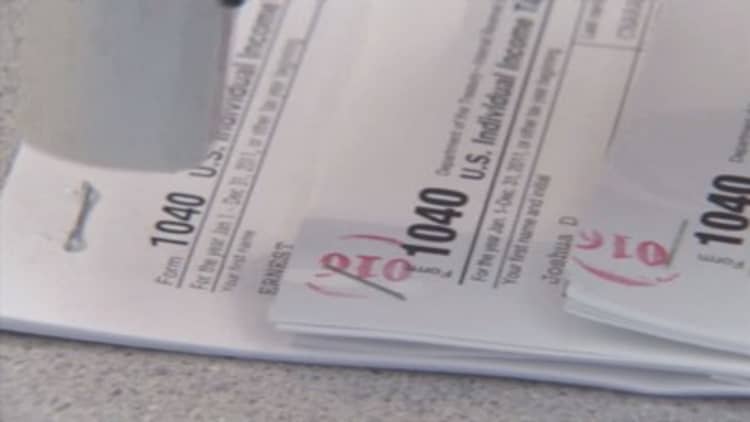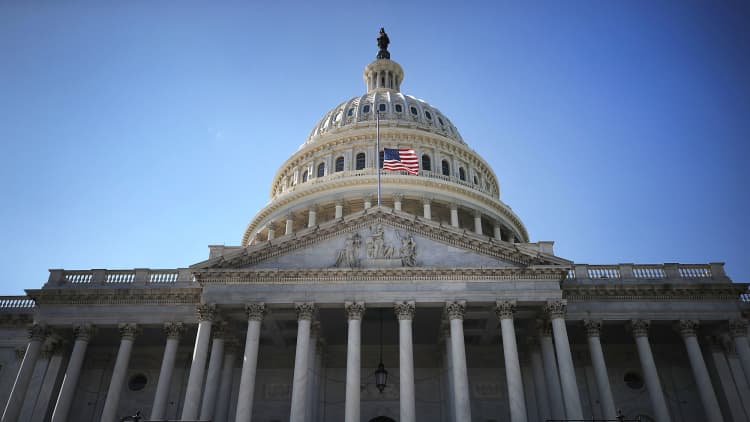
The federal deficit could rise by a whopping $154 billion over the next eight years if just five states adopt measures to protect residents from the impact of the recently passed Trump tax law, according to a new report.
California and New York alone could spark an increase of more than $110 billion in the deficit if they take such actions, the Bloomberg report published Wednesday estimated.
Those two states and three other Democratic-leaning ones examined in the report are actively considering the moves because the tax legislation passed in December will eliminate billions of dollars in deductions that their residents have been able to claim on federal income tax returns.
The actions being eyed include ending state income taxes and having the same amount of revenue collected by the state through employer-paid payroll taxes.
Another idea is to allow residents to make a charitable donation to the state equivalent to what their state income tax liability would be.

Residents, in theory at least, would be allowed to deduct 100 percent of the amount paid in those two ways — as opposed to a new, lower amount contained in the tax legislation.
That new legislation pushed by the Trump administration sets a $10,000 cap on the amount of state and local taxes that people can deduct from their incomes reported on their federal returns.
The cap will have the biggest impact in states that have high income and property taxes, where people were much more likely to itemize their federal returns.
That's because the amount deducted when itemized could exceed the standard deduction previously available to filers who do not itemize their taxes.
But the new law nearly doubled the standard deduction, which at $12,000 for individuals or $24,000 for joint filers will exceed the cap for deducting state and local taxes.
In New York in 2015, the average resident's state and local [SALT] deduction was more than $22,000, according to the Tax Policy Center — more than double the cap imposed in the new tax law.
In California and New Jersey the deductions were worth about $18,000, on average.
Nearly 14 percent of California residents itemized their federal taxes with a state and local deduction, while 7.5 percent of New York residents did so.
Conversely, the percentage of residents who did so in those states' neighbors was relatively paltry.
Just 1.5 percent of Oregon's residents took SALT deductions, and only 0.2 percent of Vermont residents did so.
In addition to New York and California, the high-tax states of Illinois, New Jersey and Connecticut are among those contemplating reworking their tax codes to limit or eliminate the loss of deductions by residents under the new law.
"The whole intent is to ensure that you get the benefit of the deduction you would otherwise lose," said Joseph Bankman, the Ralph M. Parsons professor of law and business at Stanford Law School.
Bloomberg's report, prepared with University of Chicago law professor Daniel Hemel, estimated that California could protect $66.8 billion of its residents' tax deductions over the next eight years if it took steps to reform its tax code in light of the new law. The average SALT deduction in California in 2015 was $18,400.
New York could protect $50.6 billion in deductions, according to the article.
Illinois could shield $16.8 billion in deductions, and New Jersey could protect $12.5 billion.
Connecticut, where just 1.6 percent of residents claim SALT deductions, could protect $7.5 billion in deductions by making changes being contemplated for the tax code.
Although Connecticut has a small population and relatively few taking the SALT deductions, the state has a disproportionate number of wealthy people, which is why the deductions at stake are so high there.
Connecticut had the second-highest average SALT deduction in the nation, after New York, at $19,700.
WATCH: Cramer says deficit hawks folded on GOP tax bill



